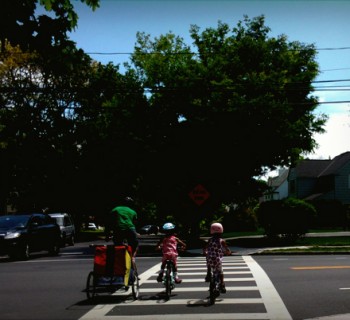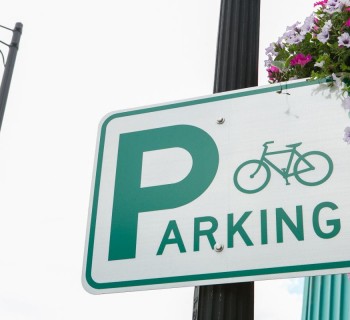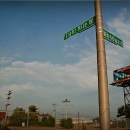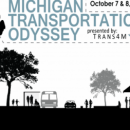Editor's Note: This article first appeared on Sustainable Cities Collective and is reposted with permission.
I was in Birmingham recently for the excellent Cycle City Expo where hundreds of cycling campaigners, road engineers, and local councils came together to think about really getting Britain cycling. There was a palpable atmosphere that the new age of the bicycle was well on its way, and indeed that "something" will need to be done on our streets to help accommodate it. But just what should be done is still very much up for debate, and this was brought home to me by a conversation I had with an engineer there who was exasperated with cycling campaigns.
"You cyclists don't know what you want!" the engineer exclaimed. His outburst came as a shock to me.
I'd been telling him about the latest design trend for road narrowing schemes that is sweeping our capital. I'd told him that such a design had been built on the Bethnal Green Road and provoked an incredible reaction from people who ride the road everyday, and that in Westminster plans to narrow the carriageway on Haymarket had people who ride there up in arms.
I explained my view that road narrowing puts people on bikes at a disadvantage, cutting their ability to get ahead of stationary traffic, bringing them closer together with heavy moving traffic and leading to dangerous overtakes by drivers who don't realize that cyclists are supposed to take the lane, or worse, just grow reckless and impatient.
I told him that I thought plenty of cyclists hated such schemes and would do anything they could to avoid any such future projects being implemented on busy roads and key cycle corridors. Many people have told me they feel intimidated and bullied by motorized traffic when they are brought closer together by road narrowing, and recounted horror stories of road aggression, near misses and uncomfortably close passes.
That's when the engineer started to sigh, scratch his head, and look at me in an exasperated way.
"Don't you see?" he began to explain, "Cyclists have been asking for road narrowing schemes for years. And now they are being built, you are telling me that cyclists hate them. You cyclists don't know what you want!"
"Don't you see?" he began to explain, "Cyclists have been asking for road narrowing schemes for years. And now they are being built, you are telling me that cyclists hate them. You cyclists don't know what you want!"
I couldn't quite believe what I was hearing, so I asked the engineer to explain further. He agreed, on the condition that I kept his identity confidential so as not to prejudice some bicycle-friendly measures he is currently working on with a London council.
"I've worked on a road narrowing scheme before. The client, the Council, wanted to turn an A-road in to a more people friendly street, most particularly with regards to accommodating all of the cyclists, who in recent years had become the majority of the traffic on this particular stretch.
"The road is also a bus corridor, and busy with lots of pedestrians. A shopping centre had been built on the road recently and there was a big pot of Section 106 money set aside for streetscape improvements.
"There was enough space to build really good cycle tracks, and increase the width of the pavements for pedestrians, as well as to accommodate pull-ins for the buses and loading bays for the shops. At first I thought that would be the best option to build; something for everyone. But the local cycling campaigners disagreed."
My heart sank at the words "local cycle campaigners"; whilst I know there are hundreds of highly committed individuals up and down the country doing outstanding work, sadly amongst their number there is still a highly vocal minority wedded to some very strange ideologies regarding how best to provide for cyclists.
"The local cycling campaign drew our attention to the Hierarchy of Provision. It's a Department for Transport standard, you must have heard of it?" quizzed the engineer. Indeed, I had.
The "Hierarchy of Provision" can be found in the DfT's briefing LTN 2/08 Cycle Infrastructure Design. It is also the foundation guide for all of the CTC's approach to campaigning and the basis of their recent design brief Cycle-friendly design and planning.
In a nutshell, it tells urban designers and road engineers what they should do when considering the place of cyclists and supposedly cycle-friendly measures.
It says that Dutch-style infrastructure should be considered as a 'last resort' after traffic reduction, traffic calming and speed reduction, junction treatments and painted bicycle lanes or shared bus lanes.
Everyone knows that overt traffic reduction is a politically impossible request, so the first practical suggestion on the list of considerations is speed reduction and traffic management.
"Don't you see?" said the engineer, "The local cycling campaign showed us the Hierarchy of Provision and made it perfectly clear that even though there was space for really good quality cycle tracks where our scheme was being constructed, they didn't want them.
"They pointed to the DfT's guidance and, well, frankly it isn't the place of a road engineer to take on the might of the Department! They showed us that cycle tracks weren't wanted, necessary or welcome.
"In fact, one or two of them had some funny ideas about cycle tracks being an invitation for trouble and danger, and the last thing I want is some kind of liability issue arising out of my work. So I followed the guidelines and did what it asked; we narrowed the carriageway as much as we possibly could. It slowed the traffic down - down from about 40 mph on average to about 25 mph today.
"It also meant there was room to put in a few extra trees and benches and bike stands, which is great, obviously. We reduced the speed, and managed the traffic, just as the cycling campaigners had asked us to."
At this point the engineer's face grew dark. He even looked angry. Downing the last of his coffee he pointed at me and said again "Cyclists don't know what they want!"
"We did what the campaigners asked. We did what the guidance from the DfT asked, which I understand was written with input from the CTC. We reduced traffic speed. We put in place a system that managed traffic. We didn't leave room for reckless driving. But it's been terrible. The Council are furious with us!
"Firstly, the volume of cycle traffic on the route dropped off by about a third. You have to remember that cyclists used to be the majority of traffic here; that's a big deal.
"Worse still, the instances of pavement cycling have shot up. The local Police had non-stop complaints from shop keepers and local residents about people cycling on the footway during the rush hour because the traffic is at a standstill and cyclists can't get through on the narrowed road. I admit it, what's the point of riding a bike if you can't go faster than all of the stationary traffic stuck in jams?!"
"Then, last month there were two terrible accidents on the road. It turns out that in order to skip the stationary traffic, but avoiding cycling on the pavement, some people on push bikes have been riding down the outside edge of the lane - that is to say they've been riding down the middle of the whole road - like a motorcyclist would. Someone on a bike got hit head-on by a motorbike coming the other way. It was a really nasty crash."
"Then the other crash was when a driver tried to over take a cyclist in the middle of the lane whilst the traffic was moving. Technically the cyclist was doing the right thing, but the driver, either through ignorance, or impatience, or both, tried to overtake.
"Our design was supposed to 'discourage' over taking, but it hasn't worked. The driver went for it, misjudged the distances and crashed in to a pedestrian refuge in the middle of the road. It could have been very serious."
I suddenly felt sorry for the engineer. Designing a street on which cyclists, buses, lorries, pedestrians and cars have to interact is a huge responsibility, and the individual obviously took the consequences of his work very seriously indeed.
He continued; "After the crashes, and with all the pavement cycling going on, we went down there to actually talk to the road users to try and find out where our design was going wrong.
"We spoke to some taxi drivers who said they hated the road now; they had no idea that cyclists were supposed to ride in the middle of the road and said they always felt unfairly held up when the traffic was moving.
"We also spoke to some of the cyclists and every single one of them really hated it. They told us that our new design made them feel in more danger than before, and that they didn't want to have to ride their bikes as though they were cars.
"They felt that there was no room for mistakes on the narrowed road, and most of them admitted to skipping on to the pavement when the traffic came to a standstill, of it they felt they were riding too close to big vehicles likes trucks and buses.
"I asked them all, if they had a choice between narrow slow roads, or less narrow roads with cycle tracks, which would they choose. Nearly all of them chose cycle tracks; the very thing we had not built. So you see my point now; cyclists, and their representatives, don't know what they want!"
I couldn't quite believe what I was hearing; cycling design guidance had been used to create the very last thing that any normal cyclist would want.
Whilst I think the creation of the Hierarchy of Provision came from a well-meaning place, the episode over coffee with a design practitioner showed me that in reality it simply isn't fit for purpose.
Except for some stringent vehicular cyclists, I am yet to meet a single cyclist who thinks that road narrowing schemes on major roads like the Bethnal Green Road are a good idea.
That the very guidelines which have been drawn up to supposedly protect people on bikes are now being used as an excuse to create conditions which actually threaten them is perverse in the extreme.
The Hierarchy of Provision fails because it tries to be a "one size fits all" fix for all roads, regardless of what the primary use of those roads might be, and because it is far too open to interpretation.
Road narrowing (and shared space) could be a useful tool available to us in our quest to create a more liveable city, but only when used in the right context.
On primary transport corridors which throng and heave with cyclists as well as buses, trucks and cars, it is clearly an unmitigated disaster. It is no good suggesting a series of measures to help cyclists without first considering what the street it is being applied to is being used for.
The Hierarchy seems to me to be a document from another age; a less-cycled, less knowledgeable age. Dare I say a pre-internet age where we weren't able to see, and understand, the other options available to us just over the North Sea in more successful cycling countries.
The Hierarchy of Provision is like Communism; perfectly well-meaning on paper, but a disaster in reality. When interpreted in to the real world it equals a harrowing experience on our streets.
That an engineer waved a copy in front of me as being the basis for introducing a dangerous and uncomfortable road narrowing scheme just goes to show how far those interpretations can go, and how entirely unfit for purpose our cycling design guidelines are.
There may be one or two campaigners in our midst who very much like the idea of bicycles behaving as vehicles and taking their "rightful place in the road," but as road narrowing schemes demonstrate, when it comes to actual everyday and ordinary cyclists using these designs, the reality does not live up to the rhetoric.
The alternative solutions are well-documented and already exist, it is time for our cycling campaigns to go back to the drawing board together and start again with our cycling design guidelines, before every other road in our city is narrowed.
In brief, cyclists must decide what they want.













